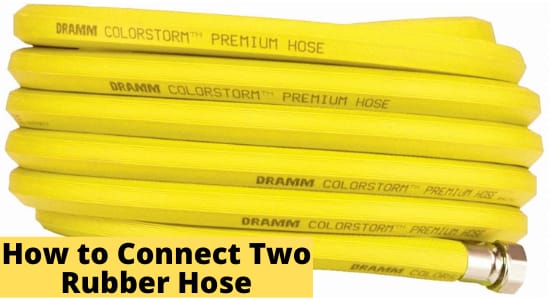Connecting two rubber hoses is better and inexpensive than installing the new water line in your garden. It is cost-efficient to get large hoses by connecting two smaller rubber hoses. How to connect two rubber hoses?
It is pretty easy; you will need adapters and connectors while joining two rubber hoses. No worry, you can finish this job with standard tools but make sure the size of both houses should be the same.
Once you read the below article, you will be able to connect rubber hoses yourself. Keep reading this guide to learn simple techniques for rubber hoses connection with different pipes and fittings.
How to Connect 2 Rubber Hoses Together?
You have the option to connect the rubber hoses by installing the connectors or couplers. The process is similar for both. Garden rubber hoses have male and female hose thread connectors.
You need to install and connect the female and male connectors; that will not take more than 5 minutes. Both of the connectors come with 3/ 4 inches thread connection. A barbed rod in 1 / 2, 3 / 4, or 5 / 8 is designed to fit inside the connectors. You can connect with a crimp ring and screws.
When needed, follow below simple steps:
Step 1- Cut the hose
Cut the ends of both hoses with a sharp utility knife. Ensure the hoses’ end cuts should be straight and even; otherwise, you will face difficulty while connecting.
Step 2- Install the barbed rod
Once the end cuts, take the barbed rod and forcedly fit the rod into the hose. Ensure the ends of the hoses are entirely flush with the connectors.
Step 3- Fit Crimp ring and screws
Next, fit the crimp ring around both of the ends of the hoses. Then join its two halves with the screws. Make sure they are correctly fitted.
Step 4- Tighten the screws
Finally, tighten up the screws around the crimp ring with the screwdriver. When screwing, make sure it is properly tightened and there is no leakage. Now your rubber hose with extended length is ready for watering.
If you have the couplers, follow a similar process, but couplers are only used when you have the same hose diameter. Otherwise, use connectors to connect two rubber hoses.
How to Connect a Rubber Hose to a Metal Pipe?
We need to connect rubber hoses with a metal pipe in different applications. You may need to connect with a gasket, radiator, cooling system, and many other applications.
It is pretty simple to connect a rubber hose to a metal pipe but ensure the rubber hose’s diameter should be the same as the metal pipe and rubber hose. Follow the below simple guide to connecting rubber hoses to metal pipes.
Step 1- Arrange tools and material
First, measure the metal pipe diameter and arrange a rubber hose of a similar diameter. You will also need a screwdriver, screws, and clamps.
Step 2- Fit the pipe into the rubber hose.
Then fit, forcefully fit the metal pipe to the rubber hose. Make sure it should be entered 1 inch or more. Before fitting the pipe to the rubber hose, put the clamps around the rubber hose.
Step 3- Screw the clamps.
Bring the clamp at the ends of the hose and screw them tightly with the screwdriver. Ensure there is no leakage, especially when installing it for the fuel line.
How Is a Rubber Hose Connected to a Metal Fitting?
We need a connection of rubber hoses to metal fittings in different DIY and commercial applications. When required, follow below simple steps.
Step 1- Arrange brass hose connectors.
Brass hose connectors offer a pretty simple solution when connecting rubber hoses with metal fittings. Arrange a similar diameter range of brass hose connector as the metal fitting.
Step 2- Nip up the hose connector.
Then nip up the hose connector and lock parts to make them suitable to fit into the connector.
Step 3- Work with collar feed.
Next, undo the collar and feed that through onto the hose into the teeth.
Step 4- Tight, secure lock
Then tighten the secure lock so that it won’t pull off. Do it gently; it should not be jointly locked. Push up to tap the connector and fit it tightly, and that’s done.
How to Connect 2 Long Rubber Hoses?
You will need quick connectors when it needs to connect long rubber hoses or when water is running. Buy a pair of quick-connect adapters, male and female, and screws to screw them tightly.
Step 1- Pull the ring
Start with pulling the spring-loaded ring; it will be on the female connector back.
Step 2- Connect the male connector to the female.
Next, insert the male connector into the female connector and forcefully push it to fix it correctly.
Step 3- Connect the rubber hoses.
Finally, release the ring on the female connector and lock the two rubber hoses together.
Can You Connect the Rubber Hose With Metal Fittings?
Rubber hoses are very sensitive to vibration and pressure. They are found effective to use with metal fittings. But these are not the most recommended because they cannot stand against the external force. However, braided lines are better than standard rubber hoses.
What Precautions Should You Take While Using Rubber Hoses With Metal Pipes?
When using rubber hoses with metal pipes, do not forget to consider the precautions. Because metal and rubber hoses do not have the same strength.
Always check the temperature and pressure range and arrange the best rubber hose according to pressure and temperature. Otherwise, it will lose and will be removed. It will be risky when used for fuel; you may be at risk of fire or other damages.
How Can You Secure High-Pressure Rubber Hoses?
It can be hazardous when using high-pressure rubber hoses. You should use Whipchecks to reduce accidents or injuries. It extends across the hose fittings that ensure standby safety for the rubber hose.
Conclusion
Connecting two rubber hoses is an affordable solution than buying the longer ones. Not just cheap, it is also pretty easy. You can connect rubber hoses with metal pipes and fittings. In three to four steps, you can connect rubber hoses with other rubber, metal pipe, or metal fittings.

